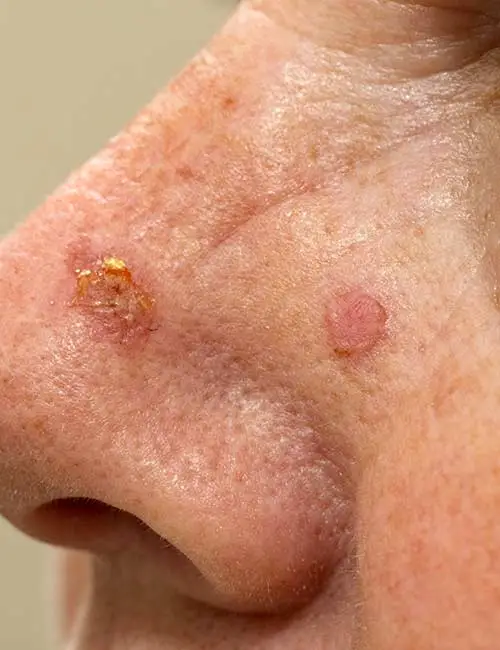Actinic Keratosis
Actinic keratosis is a term derived from the Greek roots: actinic, meaning light; and keratosis, meaning a thickening or roughness of the skin’s outer surface. These appear as small persistent reddish-brown or gray, rough, scaly spots. Sometimes it may be easier to feel them than to see them. Sometimes the lesion will sting or burn, and sun exposure may heighten these symptoms.
Other signs of prolonged sun damage, including variable degrees of skin wrinkling, thinning, yellowing, reddening, and scaling, are usually also present to some degree.
What causes actinic Keratosis?
Chronic repeated sun exposure is the major cause of these growths, and people with fair complexions are at highest risk. This is because their skin has less melanin our natural pigment, which filters out ultraviolet rays of the sun. In the United States, Arizona has the highest incidence of actinic keratosis and skin cancer because here the exposure to the sun’s ultraviolet spectrum is greatest during the course of the year.
Treatment
Actinic Keratosis are not skin cancers. However, they always require medical treatment because they are pre-cancerous (prone to become malignant). If treated at an early stage, these pre-cancers are highly curable. Depending on the size, location, and depth of the lesion, treatment may be freezing, using a cold substance called liquid nitrogen; or it may be application of burning cream called 5-fluorouracil (5-FU), particularly for multiple extensive actinic Keratosis; or in some cases surgical removal.
Prevention
Develop a lifetime habit of sun sense. Avoid excessive sun exposure. Follow the few simple steps for sensible sun protection:
Watch the time. The sun’s rays are most potent between 10:00 a.m. and 2:00 p.m., when the sun is almost directly overhead. Try to schedule outdoor activities for early morning or late afternoon.
Cover up for comfort and protection; use a sun hat and tight-weave, light-colored clothing. Use a sunscreen with a sun protection factor (SPF) of at least 15. Use a sunscreen lipstick protectant balm for the lips. Avoid tanning salons and booths, sun reflectors, and lamps.
Outdoor activities, fresh air, and exercise are important. With proper protection, following the simple steps listed above, and using common sense and moderation, we can now enjoy the outdoors without sustaining sun injury to the skin.
Follow-up
Remember that sun damage to the skin accumulates year after year, and the ’fertile soil’ for the development of additional precancerous Keratosis and/or cancerous skin lesions is already laid. Therefore, not unexpectedly, new lesions will develop, but this should not be reason for discouragement. The problem will certainly be lessened with good sun protection, and it can always be controlled with regular checkup visits.





